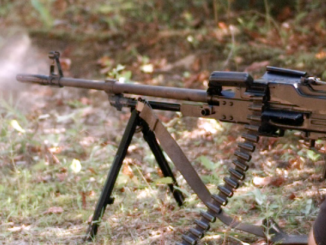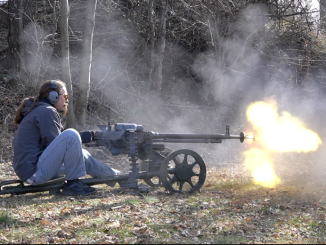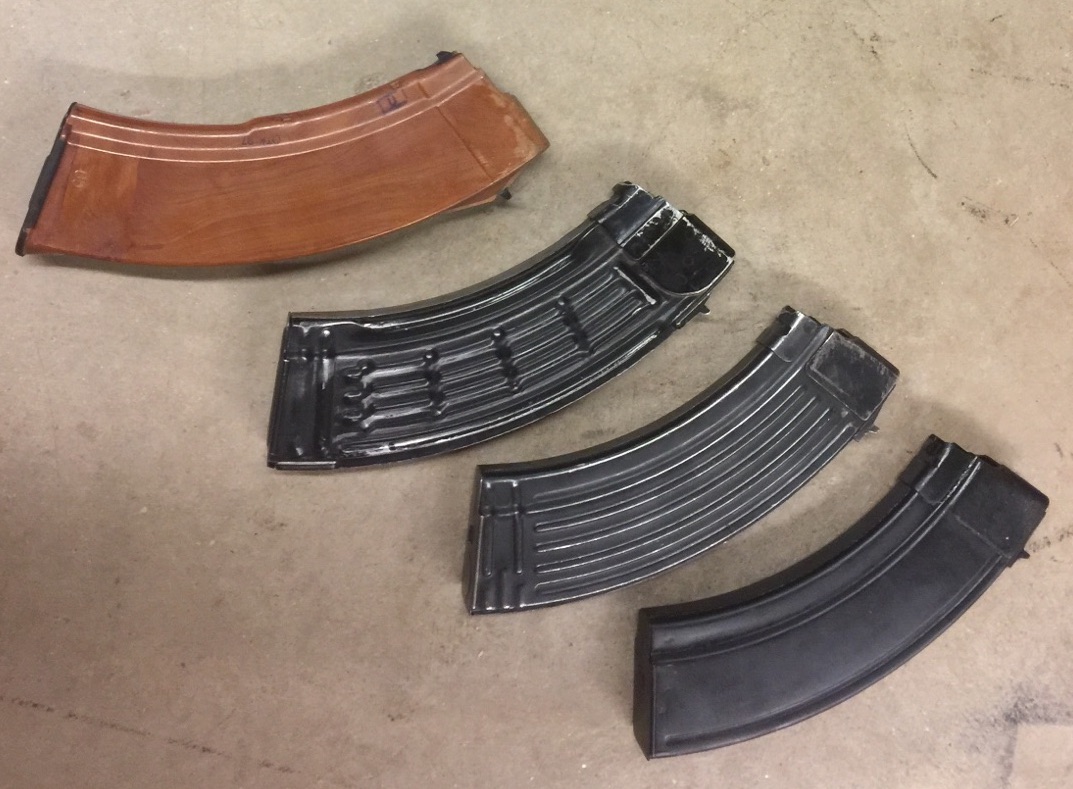Sorry for the lack of post yesterday, guys. My day job has gotten a bit hectic in the last week, and it’s really cutting into the time I have available to work on the site. Between that and another project, there will probably be some more quiet days over the next couple months. That said, writing here is still my favorite part of the day, and I’ll do my best to keep the content coming.
Actually, yesterday’s silence is a bit embarrassing in light of the fact that the post I had planned to do was just a ripoff from Soviet Gun Archives. A couple days ago they had another very cool post, this time on the subject of Soviet anti-tank rifles. They found some WWII-era documents recording tests done with 14.5mm AT rifles (type not specified, but presumably the PTRS or PTRD) and the 12.7mm DShK machine gun against various types of German tanks. They tested different ranges, armor thicknesses, and armor angles, and the results might surprise you – check it out:




Blum?
An experimental Soviet AT rifle, which I’ve been able to find very little information about.
http://weaponland.ru/load/protivotankovoe_ruzhe_bljuma/145-1-0-852
Description of Blum anti-tank rifle but in Russian, but you can see the photo of this firearm. This gun was single-shot design.
Блюм Михаил Николаевич – soviet gun designer
http://nnm.me/blogs/smprofi/blyum_mihail_nikolaevich_sovetskiy_oruzheynik/
He designed
-Blum machine-gun firing .22 Long Rifle round, it was used as a training device – attached to Maxim 1910 or Degtyarev machine gun. Production – 2698 pieces.
-12,7mm anti-tank rifle from 1939, prototype
-14,5mm anti-tank rifle after-mentioned in link. This gun used the BULLET of 14,5mm but not the 14,5x114mm CARTRIDGE. This rifle was chambered for 14,5×147 – this was 23mm aircraft cannon [VYa-23 I suppose] case necked down to accept 14,5mm bullet.
Addition: The 14,5×147 was not most powerful round tested in Soviet AT rifle. The competitor was “Противотанковое ружье РЕС” i.e. Anti-tank rifle RES.
http://weaponland.ru/load/tjazheloe_protivotankovoe_ruzhe_res/145-1-0-849
The RES is for designer names – Системы Рашкова, Ермолаева, Слухоцкого = system of Рашкова, Ермолаева, Слухоцкого. It uses the case from 45mm AT gun necked down to accept 20mm bullet (as you can see in link).
I’m not sure if that cartridge is inspired or just mad.
Neat! I have fired two PTRD 14.5 MM ATRs that we captured in South Viet Nam. While they were very powerful and had a tremendous recoil, they were not very accurate. The barrel recoils in it’s cradle to help absorb some of the recoil. No one could tell if it worked or not because the recoil was so fierce! But it was almost impossible to guarantee a hit on a five gallon Gerry can at about 125 yards range. At least one or two of every five bullets missed. Fine accuracy when shooting at tanks which are half as big as a house. One Minute of Tank as we used to say about deer rifles.
Sounds like you found guns with damaged crowns, or particularly poorly made barrels. No reason for a single-shot weapon like that to be particularly inaccurate…
It seems that the recoil mechanism if worn, causes lots of dispersion due to jump differences between shots. While the bores and crowns were good, neither weapon shot well.
Perhaps the weapon you fired was a worn out example? I recently read the wartime biography of a Soviet junior officer assigned to a penal battalion. The big AT rifles featured rather in his narrative and seemed to be surprisingly accurate and effective. Even against late war tanks they appeared useful vision blocks and other weak areas.
The 14,5mm rifle is rather poor weapons against heavy tanks but still viable option against not-tank AFV (armored car, half-tracks)
All I can say is a veteran infantry officer mentioned several times that the AT rifles used by his men provided useful service against enemy tanks in the mid- to late-war period. I was surprised by this but have no reason to question the opinion of someone who was there to see the results firsthand. If anyone I’d interested, the book in question is “Penal Strike: The Memoirs of a Red Army Penal Company Commander, 1943-45” by Alexander Pyl’cyn. I have the Stackpole edition from 2009.
Considering how old and varied most NVA equipment was, Steward and Alexander might have fired the same rifle, 25 years apart. 😀
If you wonder what the hell T-VI tank is – it is Tiger tank or Pz.Kpfw.VI, the Russian refer to the German tank as a T-I for Pz. I, T-II for Pz. II, T-III for Pz. III etc.
The tanks were probably IV F as heavy, IV D as medium and III D as light from the armor values mentioned. Which fits with an early 42 or so test. Panthers and Tigers weren’t around yet.
This is eye opening stuff. Not that PTRD and PTRS were not known, but as article with Daweo’s kind assistance suggests, there was lots of effort done by Red Army supply service to equip its soldiers adequately (or at lest to some degree) when combating armour. This must have created trust and assuring feel in minds of people using them. It shows that RA did not just ‘throw’ people away during its epic struggle.
“there was lots of effort done by Red Army supply service to equip its soldiers adequately (or at lest to some degree) when combating armour”
true and false – in the early stage war the Red Army was equipped with 14,5mm AT rifles effective against early tanks, but later they don’t produce the effective portable anti-tank weapons – neither recoilless gun or rocket launcher.
The first of RPG line the RPG-1 was designed in 1944-45 but it don’t enter service.
The designing of SPG-82 started in 1942 but it enter service as late as 1950.
Both of these weapons use the “recoilless gun” principle. Interesting fact: in 1930s L.Kurchvesky designed the whole family of recoilless guns (from 37mm anti-tank to 305mm naval gun), but only few enter service – one of this gun was 76,2mm-bore car mounted gun – the whole vehicle was named СУ-4 (latin SU-4).
As stated here: http://ru.wikipedia.org/wiki/СУ-4
At least one SU-4 was used in 1941 to fight with tanks.
Slightly off-topic, but makes you wonder if having a massive hand loaded cannon on a tank was good idea as opposed to a fast firing medium calibre autocannon.
http://www.dtic.mil/ndia/2003gun/boren.pdf
The latest APFSDS rounds for the Bofors 40mm (granted the post war L/70 variant) can penetrate upwards of 120mm of RHA, this would mean that it would be capable of penetrating the front armor of a IS-3 heavy tank.
The 88mm could fire a maximum of around one round every 3 seconds, the L/60 can do two rounds every second… greater chance of a hit, and more targets can be engaged in a given time.
The most of modern anti-tank devices will simply overkill WW2-era tanks and AFV.
120 MM of RHA Plate means at 0 degrees of incidence. Since all modern, post T-34, tank armor is slopped, there is no possibility of taking a heavy IS-3/Tiger-II, or possibly even Panther from the front with this ammo. Also think about what would happen if the vehicle was not nose on to the shooter, but was instead say 20-30 degrees side angle?
The problem with 40 MM is the AP performance will not do tanks and is much more than enough to do anything less.
Don’t know if anyone caught this, but I forwarded the link to a bunch of friends and commented on what I thought was an odd comment by one of the local Soviet commanders. In the letter dated (IIRC 7 July 1941). while the Sovs are getting their heineys kicked BY the Heinies, the Soviet commander is grousing about the lack of decent food…AND, get this, condiments such as mustard and horseradish..”Where is the HORSERADISH??? THERE MUST BE HORSERADISH!!!”. Note the date of the letter is just about two weeks after the beginning of Barbarossa, when mere survival was more on the minds of the average Soviet trooper (and Generals)…Dunno about everyone else, but I find this seriously amusing. Like the Captain in Mr Roberts and his palm tree or Cpt Queeg and his strawberries…
Broz – excellent site/blog – thank you Ian for discovering and passing this on!!!
Given the general obscelescence of AT rifles by end of 1942, did the Soviets much use them as long range sniper rifles or even for just harassing fire? They seem surprisingly common in British photos from North Africa where the chance of ambushing a tank in the desert at close range must have been nil. I wonder if the POMS just fired the occasional shot at the opposition ‘sangers’ about a klick away to say “Keep your head down” and maybe even score a hit once in a while.